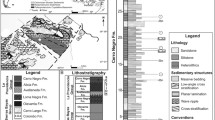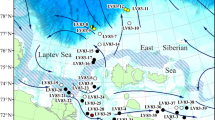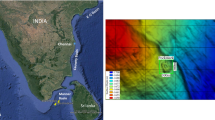Abstract
The world of protists remains largely unexplored. A thorough electron-microscopic investigation of a few microlitres of deep-sea sediment from 2,964 m water depth near the South Sandwich Islands (Southern Ocean) revealed siliceous scales of filose-amoeba protist species, two of which have not been reported previously from Antarctica or from elsewhere in the Southern Hemisphere. However, all the species are known from other oceans and, in one case, from freshwater habitats. The Antarctic protistan scales belong to four species of filose amoebae: Pinaciophora fluviatilis Greef 1869, Pinaciophora denticulata Thomsen 1978, Pinaciophora multicosta Thomsen 1978 and Rabdiaster reticulata (Thomsen 1979) Mikrjukov 1999 nov. comb. Our study shows that (1) none of the species has been recorded from the Australasian biogeograpical region, (2) Pinaciophora multicosta and Rabdiaster reticulata are new records for the Southern Ocean and for the Southern Hemisphere as a whole, (3) prior to this investigation, Pinaciophora multicosta had been reported once only, from the Baltic Sea (Europe). These results highlight the problem of undersampling in the study of the global distribution of protists.



Similar content being viewed by others
References
Adl SM, Simpson AGB, Farmer MA, Andersen RA, Anderson OR, Barta JR, Bowser SS, Brugerolle G, Fensome RA, Fredericq S, James T, Karpov S, Kugrens P, Krug J, Lane CE, Lewis LA, Lodge J, Lynn DH, Mann DG, Mccourt RM, Mendoza L, Moestrup Ø, Mozley-Standridge SE, Nerad TA, Shearer CA, Smirnov AV, Spiegel FW, Taylor MFJR (2005) The new higher level classification of eukaryotes with emphasis on the taxonomy of protests. J Eukaryot Microbiol 52:399–451
Barnett PRO, Watson J, Connelly D (1984) A multiple corer for taking virtually undisturbed samples from shelf, bathyal and abyssal sediments. Oceanol Acta 7:399–408
Belcher JH, Swale EMF (1978) Records from England of the Helizoan-like organism Pinaciophora fluviatilis Greef and of its scales, “Potamodiscus kalbei” Gerloff. Arch Protistenkd 120:367–370
Caron DA (1991) Heterotrophic flagellates associated with sedimenting detritus. In: Patterson PJ, Larsen J (eds) The biology of free-living heterotrophic flagellates (systematics association), special vol 45. Clarendon, Oxford, pp 77–92
Caron DA, Davis PG, Madin LP, Sieburth J McN (1982) Heterotrophic bacteria and bacterivorous protozoa in oceanic macroaggregates. Science 218:795–797
Croome RL (1987) Pinaciophora columna n. sp., P. tasmanica n. sp. and P. apora n. sp., new Heliozoeans from Australia, and a report of P. fluviatilis Greef from Antarctica. Arch Protistenkd 133:15–20
Croome RL, van den Hoff J, Burton HR (1987) Observations of the Heliozoean genera Pinaciophora and Acanthocystis (Heliozoea, Sarcodina, Protozoa) from Ellis Fjord, Antarctica. Polar Biol 8:23–28
Finlay BJ, Clarke KJ (1999) Apparent global ubiquity of species in the protist genus Paraphysomonas. Protist 150:419–430
Finlay BJ, Esteban GF, Brown S, Fenchel T, Hoef-Emden K (2006) Multiple cosmopolitan ecotypes within a microbial eukaryote morphospecies. Protist 157:377–390
Gaarder KR, Fryxell GA, Hasle GR (1976) Potamodiscus kalbei Gerloff an organism with siliceous scales. Arch Protistenkd 118:346–351
Gerloff J (1968) Elektronenmikroskopische Untersuchungen an Diatomeenschalen VI. Potamodiscus kalbei nov. gen. et nov. spec. Willdenowia 4:353–361
Greeff R (1873) Radiolarien und radiolarienartige Rhizopoden des süssen Wassers. Sitzungsber Ges Beförd Gesammten Naturwiss, Marburg 5:47–64
Greeff R (1875) Über Radiolarien und radiolarienartige Rhizopoden des süssen Wassers. Arch Mikr Anat 11:1–32
Gooday AJ, Esteban GF, Clarke KJ (2006) Organic and siliceous protistan scales in North-East Atlantic abyssal sediments. J Mar Biol Ass UK 86:679–688
Guillén GK (2002) Diversidad protozoológica de los pantanos de Villa, Chorrillos-Lima-Perú. Digital collection, sistema de bibliotecas SISBIB Universidad Nacional Mayor de San Marcos, Lima, pp 151
Howe JA (2003) Recent depositional environments of the north western Weddell Sea and South Sandwich Trench. Ber Polarforsch Meeresforsch 470:124–127
Manton I, Sutherland J (1979) Further observations on Potamodiscus Gerloff = Pinaciophora Greef, with special reference to Alaska and arctic Canada. Zool J Linn Soc 67:286–295
Mikrjukov KA (1999) Taxonomic revision of scale-bearing heliozoon-like amoebae (Pompholyxophryidae, Rotosphaerida). Acta Protozool 38:119–131
Mikrjukov KA, Patterson DJ (2001) Taxonomy and phylogeny of heliozoa. III. Actinophryids. Acta Protozool 40:3–25
Nicholls KH (1983) Little-known and new heliozoeans: Pinaciophora triangula Thomsen new to North America and a description of Pinaciophora pinea sp. nov. Can J Zool 61:1387–1390
Nikolaev SI, Berney C, Fahrni JF, Bolivar I, Polet S, Mylnikov AP, Aleshin VV, Petrov NB, Pawlowski J (2004) The twilight of Heliozoa and rise of Rhizaria, an emerging supergroup of amoeboid eukaryotes. Proc Nat Acad Sci 101:8066–8071
Patterson DJ, Nygaard K, Steinberg G, Turley CM (1993) Heterotrophic flagellates and other protists associated with oceanic detritus throughout the water column in the mid North Atlantic. J Mar Biol Ass UK 73:67–95
Penard E (1904) Les Héliozoaires d’eau douce Geneva
Roijackers RMM, Siemensma FJ (1988) A study of Cristidiscoidid amoebae (Rhizopoda Filosea), with descriptions of new species and keys to genera and species. Arch Protistenkd 135:237–253
Scott FJ, Marchant HJ (2005) Antarctic marine protists. Australian Biological Resources Study, Canberra, pp 563
Smol JP (1995) Applications of chrysophytes to problems in paleoecology. In: Sandgren CD, Smol JP, Kristiansen J (eds) Chrysophyte algae. Ecology, phylogeny and development. Cambridge University Press, Cambridge, pp 303–329
Takahashi E (1981) Loricate and scale-bearing protists from Lützow-Holm Bay, Antarctica I. Species of the Acanthoecidae and the Centrohelida found at a site selected on the fast ice. Antarctic Rec 73:1–22
Thomsen HA (1978) On the identity between the heliozoan Pinaciophora fluviatilis and Potamodiscus kalbei, with the description of eight new Pinaciophora species. Protistologica 14:359-373
Thomsen HA (1979) Electron microscopical observations on brackish-water nannoplankton from the Tvärminne area, SW coast of Finland. Acta Bot Fennica 110:11-37
Turley CM, Lochte K, Patterson DJ (1988) A barophilic flagellate isolated from 4,500 m in the mid-North Atlantic. Deep-Sea Res 35:1079–1092
Vørs N (1993) Heterotrophic amoebae, flagellates and heliozoa from Arctic marine waters (North West Territories, Canada and West Greenland). Polar Biol 13:113–126
Wee JL, Millie DF (1983) A new record of Pinaciophora fluviatilis Greef sensu Penard from the Laurentian Great Lakes. J Great Lakes Res 9:433–435
Wujek DE (2005) Identification, ecology, and distribution of scale bearing amoeba, ciliates, flagellates and heliozoa from the Carolinas. J North Carolina Acad Sci 121:1–16
Acknowledgments
This is ANDEEP publication number 89. We thank the members of the scientific party, the captain, and crew of RV Polarstern (ANDEEP II cruise), for their help in collecting the samples. Participation of AJG in the ANDEEP II cruise was supported by a grant from the UK Natural Environment Research Council (NER/B/S/2001/00336). The Freshwater Biological Association (UK) is thanked for equipment and for making facilities available to do electron microscopy; the Natural Environment Research Council (UK) for financial support, and Paddy Patterson for information on geographical records of the “heliozoa” and the scale-bearing filose amoebae.
Author information
Authors and Affiliations
Corresponding author
Rights and permissions
About this article
Cite this article
Esteban, G.F., Gooday, A.J. & Clarke, K.J. Siliceous scales of filose-amoebae (Pompholyxophryidae, Rotosphaerida) from deep Southern Ocean sediments, including first records for the Southern Hemisphere. Polar Biol 30, 945–950 (2007). https://doi.org/10.1007/s00300-007-0280-4
Received:
Revised:
Accepted:
Published:
Issue Date:
DOI: https://doi.org/10.1007/s00300-007-0280-4




